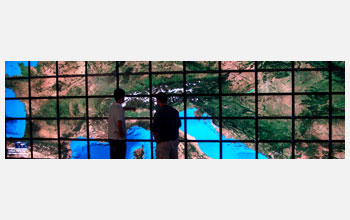Multimedia Gallery
HIPerSpace System
An interactive analysis of NASA's 3.7 gigapixel resolution Blue Marble Next Generation dataset using the HIPerSpace (Highly Interactive Parallelized Display Space) system. With a screen resolution of up to 220 million pixels displayed across 55 high-resolution tiled screens, HIPerSpace is the highest-resolution computer display in the world.
HIPerSpace was constructed by engineers led by chief architect Falko Kuester, associate professor of structural engineering at the University of California, San Diego (UCSD). It is linked via optical fiber to the UCSD division of the California Institute for Telecommunications and Information Technology's (Calit2) building at the University of California, Irvine, which boasts the previous record holder for highest-resolution tiled display screen at 200 million pixels, the HYPerWall (Highly Interactive Parallelized Display Wall). HYPerWall was built in 2005 with funding from the National Science Foundation (NSF). The combination of the two systems can deliver real time-rendered graphics simultaneously across 420 million pixels to audiences in Irvine and San Diego.
After developing the HYPerWall system at UC-Irvine, Kuester (who is chief architect of both systems) and his group moved to UCSD in 2006, where they began working on the next generation of massively tiled display walls, that now serves as a prototype for the ultra-high-resolution OptIPortal tiled displays developed by the NSF-funded OptIPuter project. To learn more, see the UCSD news story "Rocketing Into HIPerSpace: New Visualization System at UC-San Diego." (Date of Image: 2005-2008) [See related image Here.]
Credit: Falko Kuester, California Institute for Telecommunications and Information Technology (Calit2), University of California, San Diego
Images and other media in the National Science Foundation Multimedia Gallery are available for use in print and electronic material by NSF employees, members of the media, university staff, teachers and the general public. All media in the gallery are intended for personal, educational and nonprofit/non-commercial use only.
Images credited to the National Science Foundation, a federal agency, are in the public domain. The images were created by employees of the United States Government as part of their official duties or prepared by contractors as "works for hire" for NSF. You may freely use NSF-credited images and, at your discretion, credit NSF with a "Courtesy: National Science Foundation" notation.
Additional information about general usage can be found in Conditions.
Also Available:
Download the high-resolution JPG version of the image. (2.3 MB)
Use your mouse to right-click (Mac users may need to Ctrl-click) the link above and choose the option that will save the file or target to your computer.

